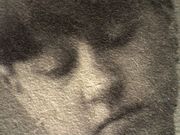Difference between revisions of "Salted paper"
| Line 1: | Line 1: | ||
[[File:woman_salt_6.jpg|thumb|Salt print]] | [[File:woman_salt_6.jpg|thumb|Salt print]] | ||
== Description == | == Description == | ||
| − | [[File:Woman-salt_18.jpg|thumb|Salt print]] | + | [[File:Woman-salt_18.jpg|thumb|Salt print close view]] |
A type of photographic [[printing out paper]]. Developed by William Henry Fox Talbot, salted paper was prepared by directly soaking paper in a solution of [[table salt]] then treating it with [[silver nitrate]]. By 1841, salted paper was made with a thin salt-filled [[gelatin]] coating that was dried then treated with silver nitrate to form a photosensitive silver halide compound. Gelatin was most commonly used as a binder, but other materials such as [[albumen]], [[arrowroot starch]], [[agar-agar]], and [[starch]] were also used. The image was produced by exposing the paper to the sun through a negative then fixed with [[potassium bromide]] or [[sodium thiosulfate]] solutions. By the 1860s, salted paper was replaced in popular use by [[albumen paper]]. | A type of photographic [[printing out paper]]. Developed by William Henry Fox Talbot, salted paper was prepared by directly soaking paper in a solution of [[table salt]] then treating it with [[silver nitrate]]. By 1841, salted paper was made with a thin salt-filled [[gelatin]] coating that was dried then treated with silver nitrate to form a photosensitive silver halide compound. Gelatin was most commonly used as a binder, but other materials such as [[albumen]], [[arrowroot starch]], [[agar-agar]], and [[starch]] were also used. The image was produced by exposing the paper to the sun through a negative then fixed with [[potassium bromide]] or [[sodium thiosulfate]] solutions. By the 1860s, salted paper was replaced in popular use by [[albumen paper]]. | ||
| Line 17: | Line 17: | ||
File:Salt Print Sample 16 200x Refl.jpg|Salt print sample at 200x | File:Salt Print Sample 16 200x Refl.jpg|Salt print sample at 200x | ||
File:Salt Print Sample 16 200x UV.jpg|Salt print sample at 200x | File:Salt Print Sample 16 200x UV.jpg|Salt print sample at 200x | ||
| − | |||
| − | |||
</gallery> | </gallery> | ||
Revision as of 13:27, 28 June 2022
Description
A type of photographic Printing out paper. Developed by William Henry Fox Talbot, salted paper was prepared by directly soaking paper in a solution of Table salt then treating it with Silver nitrate. By 1841, salted paper was made with a thin salt-filled Gelatin coating that was dried then treated with silver nitrate to form a photosensitive silver halide compound. Gelatin was most commonly used as a binder, but other materials such as Albumen, Arrowroot starch, Agar-agar, and Starch were also used. The image was produced by exposing the paper to the sun through a negative then fixed with Potassium bromide or Sodium thiosulfate solutions. By the 1860s, salted paper was replaced in popular use by Albumen paper.
Synonyms and Related Terms
salt print; salted-paper; plain salted paper; papier salé (Fr.)
Additional Images
Resources and Citations
- James M. Reilly, Albumen & Salted Paper Book: The history and practice of photographic printing, 1840-1895, Light Impressions Corp., Rochester, NY, 1980 Comment: see chapter at http://albumen.stanford.edu/library/monographs/reilly/chap11.html
- Caring for your Collections, Arthur W Schulz (ed.), Harry N. Abrams, Inc. , New York, 1992 Comment: one of the earliest photographic printing process introduced in 1841
- E.J.LaBarre, Dictionary and Encyclopedia of Paper and Paper-making, Swets & Zeitlinger, Amsterdam, 1969
- Luis Nadeau, Encyclopedia of Printing, Photographic, and Photomechanical Processes, Atelier, New Brunswick, 1997
- Thomas B. Brill, Light Its Interaction with Art and Antiquities, Plenum Press, New York City, 1980






